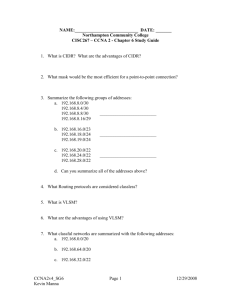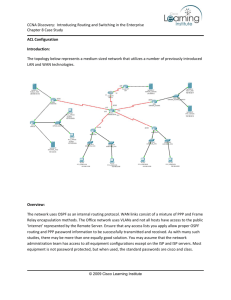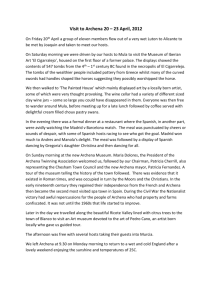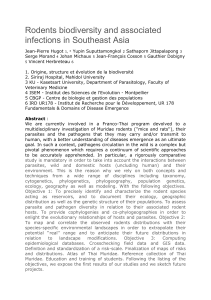Who Links to Whom: Mining Linkage between Web Sites
advertisement
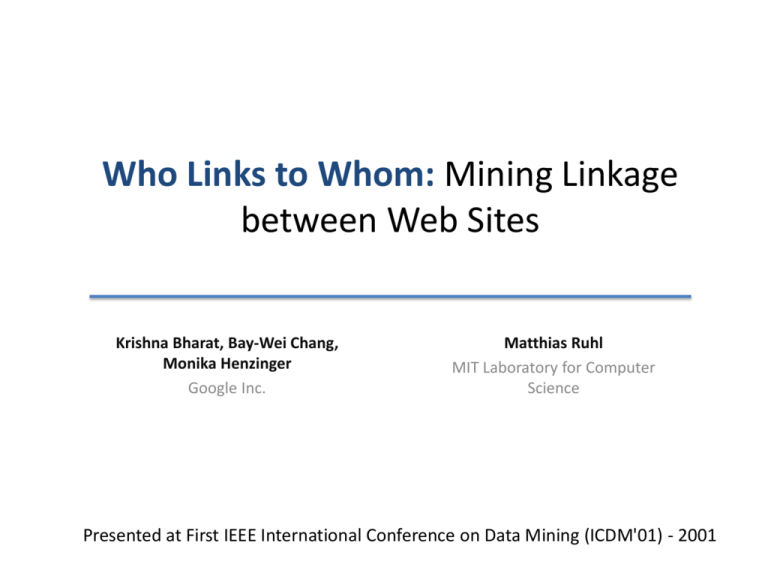
Who Links to Whom: Mining Linkage between Web Sites Krishna Bharat, Bay-Wei Chang, Monika Henzinger Google Inc. Matthias Ruhl MIT Laboratory for Computer Science Presented at First IEEE International Conference on Data Mining (ICDM'01) - 2001 Introduction Previous studies of the web graph structure have focused on the graph structure at the level of individual pages. In actuality the web is a hierarchically nested graph, with domains, hosts and web sites introducing intermediate levels of affiliation and administrative control. The authors argue that in order to better understand the growth of the web we need to understand its macro-structure, in terms of the linkage between web sites In this paper they approximate this by studying the graph of the linkage between hosts on the web The connectivity between hosts is represented by a directed graph, with hosts as nodes and weighted edges representing the count of hyperlinks between pages on the corresponding hosts. Introduction How such a “hostgraph” can be used to study connectivity properties of hosts and domains over time is demonstrated and a modified “copy model” to explain observed link weight distributions as a function of subgraph size is discussed. They discuss changes in the web over time in the size and connectivity of web sites and country domains. We also describe a data mining application of the hostgraph: a related host finding algorithm which achieves a precision of 0.65 at rank 3. Background – web graph, previous work The web is a hierarchically nested graph, with domains, web sites, and individual pages introducing different levels of affiliation and administrative control. A web page is the elementary unit. Pages usually tend to be under the editorial control of a single entity (person or organization). A web site is a collection of web pages affiliated to a single entity. A domain (short for top-level domain) consists of a collection of web hosts, all of which share the same last token in the host name (e.g., .com or .uk). Most domains are associated with individual countries, though there are large domains such as .com and .net that are not geographical. Previous studies of the web graph structure have focused on the graph structure at the level of individual pages. However, web sites might introduce a more appropriate level of abstraction. Why ? Background – why a different abstraction level ? Reason 1 - Documents are frequently represented by multiple web pages. Consequently, the full hyperdocument rather than the individual pages may be the right level of granularity for analysis. Bibliometric studies analyze the citation or cocitation between authors, usually considering linkage to or from an author’s work in aggregate. To study web authors analogously,web sites may be the right level. Reason 2 - Since the entity that owns a web site has control over all parts, the content within a site may be reorganized or revised periodically without significantly changing the semantics or linkage relative to the rest of the web. This argues for separating the analysis of inter- and intra-site linkage. Reason 3 - Since generating pages is cheap, some sites may generate a large number of pages (potentially an infinite number which are dynamically generated), skewing statistical properties that people may want to study. Background – why a different abstraction level ? ..cont Reason 4 - Concerns have been raised about accessibility of content on the web. In a previous study , it was shown that the “distance” between pages on the web is quite large with often no directed path being available (Graph structure of the web , Border et el) . This fails to account for the fact that within a given web site there are implicit paths from all pages to the “root page” (users often truncate the path of the URL to navigate to the root page), from which there should be authordesigned paths to all local content. Thus navigation within a web site is often less challenging than would appear from a naive analysis of the linkage. If we assume that sites are internally fully navigable, then the inter-linkage between sites becomes the main factor in determining the accessibility of web-wide content. The new model - hostgraph We attempt to study the web on the web site level. However, determining which pages belong to the same web site is an open problem. We approximate each web site by all the pages with the same host name and study the following weighted hostgraph: Each node represents a web host, and each directed edge represents the hyperlinks from pages on the source host to pages on the target host. The weight of the edge corresponds to the number of such hyperlinks. The new model – hostgraph example Web site 1 W1 W11 W2 W10 W3 Web site 2 Web site 6 W12 Web site 4 W4 W9 W5 W7 W8 W6 Web site 3 Web site 5 Hostgraph – what are the interesting properties ? (a) Obviously one wants to determine its size in terms of nodes and edges and observe how it changes over time. (b) Since the “average degree of separation” on the web has received considerable attention on the page level , it is interesting to study it in this coarser grain abstraction. (c) It is also interesting to see how the host level abstraction relates to the domain level abstraction, specifically to study the linkage of hosts in different domains. (d) Previous work has shown the Zipfian nature of the indegree and outdegree distribution of the page graph. It is therefore an interesting question whether the hostgraph distributions are Zipfian as well. This evidence of self-similarity would support the conjecture by previous researchers that the web graph has a fractal nature. Hostgraph – datasets They ran their experiments with three snapshots of the web, which were subsets of crawls by Google in October 1999,August 2000, and June 2001. In each case the dataset was restricted to the set of hosts reachable from a well known reference host with high in and out degree in the hostgraph. They used www.w3.org, which hosts the web site of the World Wide Web Consortium, as their reference host. They argue that exact choice of reference host is unimportant as long as we are certain that it is part of the central strongly connected component in the hostgraph, which includes all the major international hubs. Hostgraph – construction For a given snapshot of the web, a hostgraph can be computed as follows. In a linear scan through all pages, for every cross-host link we write the corresponding ordered pair of hosts to a log. At the end of the pass, the log is sorted and in a linear scan contiguous occurrences of each distinct ordered host pair are counted. Each ordered host pair corresponds to an edge in the hostgraph, and the occurrence count in the log corresponds to its weight. Hostgraph – statistics Hostgraph – Average Distance Between Hosts The distance between two hosts is the length of the shortest path between them measured in number of edges. The average distance was computed by averaging the individual distances observed. They also estimated the weighted average distance where each host is weighted by the number of pages on it Hostgraph – Inverse Power Law Distributions Previous papers have observed that various properties of the web graph follow a Zipfian distribution (a function of the form 1/nk) Kumar et al. show that the fraction of web pages with indegree i is roughly proportional to 1/i2. Barbarasi and Albert report a Zipfian exponent of 2.1 for the indegree distribution and they also show that the fraction of web pages with outdegree i is roughly proportional to 1/i2.45. Broder et al. reported an indegree exponent of 2.1 and an outdegree exponent of 2.72. They also showed that the fraction of connected components in the undirected graph has a Zipfian distribution. Hostgraph – Inverse Power Law Distributions …cont The authors show that the link structure at a coarser granularity, namely at the level of hosts and domains, also follows a Zipfian distribution. More specifically, the fraction of hosts of the host graph with weighted indegree i is (roughly) proportional to 1/i1.62 and the fraction of hosts of the hostgraph with weighted outdegree i is (roughly) proportional to 1/i1.67 Hostgraph – Inverse Power Law Distributions …cont The authors also investigated the distribution of weighted in and out- degrees for subsets of the hosts in the hostgraph, namely for top level domains such as .com and .uk. For each such subset the weighted indegree and outdegree distributions are again Zipfian. However, the size of the Zipfian exponent increases with the number of hosts in the domain. Hostgraph – Inverse Power Law Distributions …cont The authors also investigated the distribution of weighted in and out- degrees for subsets of the hosts in the hostgraph, namely for top level domains such as .com and .uk. For each such subset the weighted indegree and outdegree distributions are again Zipfian. However, the size of the Zipfian exponent increases with the number of hosts in the domain. Hostgraph – Inverse Power Law Distributions …cont The distribution of edge weights in the hostgraph, i.e., the number of distinct hyperlinks between ordered pairs of hosts, is Zipf distributed Hostgraph – Country Domain Linkage Table 4 shows some of the affinity between top level country domains in the June 2001 hostgraph. The 20 source domains with the highest weighted outdegree are included in the table; the .com domain is also included for comparison. For each source domain, we list the percentage of weighted outdegree into the same domain, into the .com domain, and into the four most highly linked country domains from that source domain. Hostgraph – Country Domain Linkage …cont In every case, there is a much higher number of links within the domain than to any other country domain; in fact, the next highest country domain typically receives around 1% of all links, in comparison to the 50-90% of intradomain links. There is also a much higher number of links to the .com domain, and even .net, and .org domains (not shown here) usually have higher linkage than other countries, (on the order of 3-7%). Hostgraph – Country Domain Linkage…cont The table also shows that, of the country domains, .de and .uk dominate. This is due to the size of those domains – there are more hosts in each of these two domains than any other country domain except for .jp. With so many web pages in .de and .uk, it’s simply more likely that a host will point into those domains. .jp may not be as highly linked to due to language differences. Hostgraph – Country Domain Linkage…cont If we ignore the presence of .de and .uk in each country domain’s top link destinations, we see that two other trends emerge. The first is that there is often strong geographical connections between a source domain and its most highly linked to domains. Examples - Germany’s most highly linked to domains are Switzerland, Austria, Netherlands and France. Norway’s are Sweden, Denmark, Estonia, Soviet Union, and Finland. New Zealand’s is Australia. The linkages are not always reciprocal, however. Examples - while China’s top linkages are to Taiwan, Japan, and Hong Kong, and Hong Kong’s are to Taiwan and China, China and Hong Kong do not show up in Taiwan’s linkages until positions 5 and 6 (again ignoring .de and .uk). New Zealand’s position on Australia’s list is not first, but fourth. Political and economic relationships might explain these asymmetries Hostgraph – Country Domain Linkage…cont The other trend is that language affiliations can override geographical affiliations. The strongest example of this is Brazil’s top linkage to Portugal, and Portugal’s to Brazil. Spain doesn’t appear in Portugal’s linkages until position 5, despite its strong geographical connection to Portugal. There is also a strong English language affinity among US, UK, Australia, and New Zealand. Examples like this support the intuition that linkages on the web are strongly influenced by shared language. Hostgraph – Mining Related Web Hosts The authors discuss possibility of using connectivity based web data mining to extract significant relationships between hosts on the web based on connectivity within the hostgraph They explain the method of discovering related web hosts using the hyperlink structure of the host graph Two forms of relatedness in the hostgraph are examined. 1 . Relatedness by Link Frequency 2 . Relatedness by Cocitation Mining Related Web Hosts - based on Link Frequency A simple technique to find related hosts is based on the pruning of edges in the hostgraph based on edge weight. Only strong edges remain, revealing connections between hosts that are stronger than mere citation. All edges in the graph with weight less than 500 are pruned. Quantitatively this reduced the set of edges to 139,900 pairs in August 2000 (i.e., the number of ordered host pairs with at least 500 individual hyperlinks between their pages),and to 34,600 in Oct 1999. Mining Related Web Hosts - based on Link Frequency They identified several explanations for strongly connected host pairs that didn’t seem to be otherwise related: Large Hosts: Large hosts like www.geocities.com and members.aol.com have high mutual edge weights by virtue of their immense size Boilerplate: Some hosts use a page template on all pages. If this template has crosshost links it leads to a high edge weight Multi-Host Sites: A site that spans multiple hosts may have many references between the hosts Spam: A large factor is the activities of “search engine optimizers” who try to manufacture highly connected graphs to promote specific web sites (especially for pornography) Affiliate Programs: Web sites like Amazon encourage third party web sites to host pages that link back to content on their site (e.g., specific books), rewarding them for the traffic sent through Mining Related Web Hosts - based on Cocitation Co citation analysis basically employed to find the related WebPages. (Netscape navigator provides this checking facility) Co citation algorithm achieved a precision @ 10 of 0.4 . The idea can be extended to the host graph. B= Set of up to 100 hosts S= node that B is pointing to with out link count < 50 Consider, candidate C if it is being pointed by at least four hosts in B BS(C)= Host on B pointing to C …..then we can compute the score of each C as, Mining Related Web Hosts - based on Cocitation…cont Example for the query www.airfrance.com the algorithm has following results. The modified co citation algorithm, thus had a precision at 3 of 0.65 Web Graph Modeling - Previous Graph Evolution Models Proposed on the basis that, each model consists of a random process that creates a graph having properties similar to properties of the web, namely, Zipfian degree distributions and a large number of small bipartite cliques. Traditionally, these models were page-based, i.e. nodes corresponded to single pages, and edges are added with some probability associated with them. One of these is the “Copy model” which meets the requirements of host graph model except for two unexplained observations :: a) The observed low indegree distribution is almost, but not entirely Zipfian, while the observed frequencies agree almost perfectly with the prediction for high in degree hosts. b) The exponent in the Zipfian distribution in the copy model depends only on “α”(the copy factor), and remains constant independent of the size of the web. But, when restricted to individual countries these Zipfian exponents actually depend on the number of hosts in the particular country. Web Graph Modeling - Hostgraph Model Authors, thus propose a modified version of “copy model” called as “Re-link” model. As in the previously known model , the web graph is created in discrete time steps. At each time step, with probability β, we select a random already existing node, u, and add new additional out links to it. These out links are computed as follows: • First, one picks a node v at random among all already existing nodes. Second, one picks d random outgoing edges from v. •Then for i = 1,2,……….d, the i-th new link of u points to a random existing node with probability α, and to the destination of the i-th link picked from v with probability 1- α. • With probability 1- β, we add a new node and then add out-links to it, just as in the copy model. Web Graph Modeling – Hostgraph model …cont This model says that the web is not only changed by adding hosts, but also by hosts changing what other hosts they link to (“re-linking”). It is different from the copy model because it makes it possible to add new links without adding new hosts. The parameter β controls how many new hosts are created. If β = 0 the re-link model reduces to the copy model. Larger the value of β, less is the probability that a new host is created. Thus, the curve flattens for low in degree hosts. Also, the curve becomes steeper, i.e., the Zipfian exponent increases. One reason might be that hosts quickly grow from small in degree to medium in degree while it takes them longer to become large in degree hosts. Thus, the model also provides a possible explanation for different Zipfian exponents for different domains. The Zipfian exponent grows inversely with value of β. Conclusions The authors main contribution is the notion of the hostgraph, both as an abstraction to study the web, and as an explictly computed data-structure for use in profiling the growth of the web and for web data mining applications. The hostgraph exhibits many of the properties of the web graph, providing another example of the fractal nature of web connectivity. A key contribution is the observation that the distributions of indegrees and outdegrees within top level domains of the web seem correlated with the size of the domain. A modified “copy model” is provided to explain this. It has been shown that preserving host connectivity information can be useful in web monitoring and growth tracking. Comparisons are made on changes in web site size and connectivity, inter-domain connectivity and web diameter estimate, to illustrate this. The host graph was also intended as a resource of data mining. How co-citation at the level of hosts can be mined and describe an algorithm which outputs related hosts with a precision of 0.65 at rank 3 is demonstrated Questions ?

